If you’ve lived in one of the great Indian mega-cities for any length of time, one of the things that you can never forget is the street food. But street food during a festival like Durga Pujo? You have to see it to believe it.
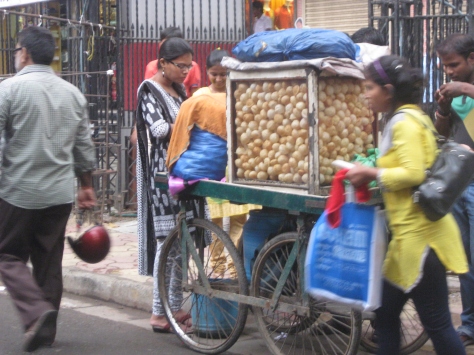
I’ve only really lived in one Indian city, Calcutta/Kolkata, and even though I grew up almost on a daily diet of various kinds of street food (my parents being a little less strict about this than many and my stomach having grown most resilient via this eclectic exposure) I wasn’t prepared for the number, scale and magnitude by which street food culture had proliferated in the city during my absence of fourteen years and the subsequent fifteen annual Durga Pujo’s I had missed.


I took all these pictures on Shoshthi evening and Shaptami afternoon, the first and second of the five days when Pujo crowds are only warming up. I just walked a little in the evening, barely a ten minute walking stretch from my parents’ place to the major road in my area. It’s a very middle-class neighbourhood and didn’t include any of the city’s major intersections or Pujo-visiting destinations or markets and must be a very miniscule picture of the city’s crowds and street foods this Pujo.
Yet, just as the spirit of the Goddess inheres in the smallest Debi idol in the tiniest by-lane in the littlelest poorly-lit Pandal as she does in the award-winning enormous mega-Pujo’s, I’m hoping that this chronicler’s mini-attempt at reflecting the spirit of the season will convey a little bit of the excitement and anticipation regarding how the Goddess has transformed a city of a 4.4 million people (14.38 million if you take the metropolitan area into account and swelling during Pujo) into a cosmic food court.
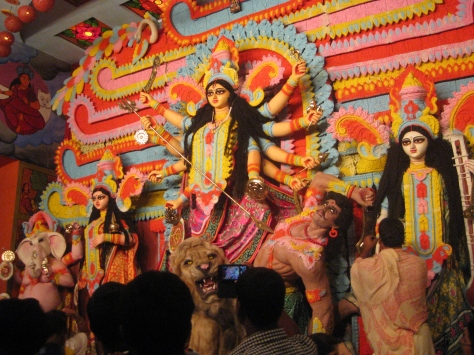
Chronicling time-sensitive material is hard work, as I discovered while writing this blog post. To experience and to record, to see, hear, and taste (a little) and to write about it very quickly isn’t everyone’s cup of tea (or I should say sweet Pujo Nescafe in tiny cups). Added to this, the talent required to photograph crowded targets and the nonverbal communication skills needed to take shots of people’s carts while they are right there doing business with hungry men and women requires special gifts.
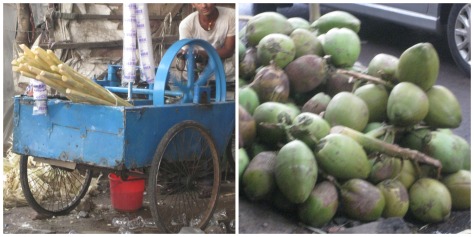
The walk takes barely ten minutes on ordinary days. Right now, the crowds, the traffic, the Pujo volunteers, the boy scouts in uniforms and the cops with their thick ropes (to control the crowds) is making the walk slower in the evenings which is when the crowds come out to see the lights.
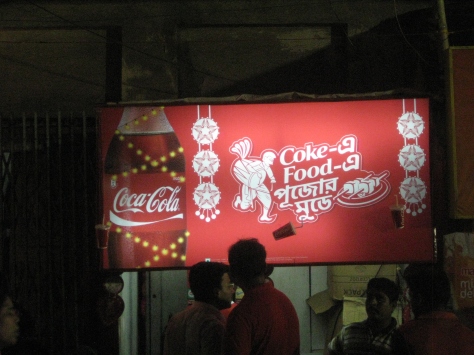

There are expected and unexpected impediments to chronicling Pujo every few steps. For example, a very cute volunteer with a badge (who looked about eight) sternly told me not to exit a Pandal the wrong way when I was trying to photograph a wall but broke into a wide smile when he saw my camera.
A traffic-control cop at an intersection jumped at the loud, angry voice of a large man, as did a huge section of the crowd crossing the road with me at the booming sound, while all geared up for a fight.
But no.
The man turned out to be simply a worried father scolding a tiny girl of about three for walking off into a different crowd stream towards a bamboo barricaded sectioned off part of the pavement for a mega-Pujo (from which she wouldn’t be able to come out for a long way and would have to exit into a different street).
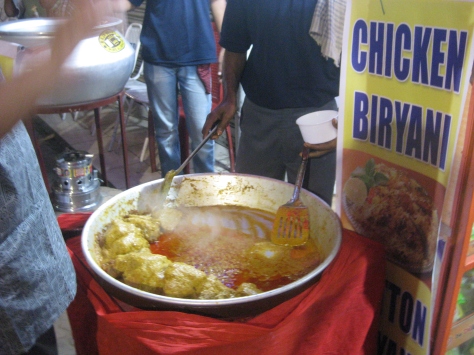
I cannot remember who it was who said that poetry (or art, or the creative imagination or whatever this impulse is to record experience with some airbrushing) is all about seeing the familiar through unfamiliar eyes, as though the everyday is something special that will never come back. It could be Tagore, the poet whose hauntings are still in every corner of this city, even now, after my fifteen years of absence, only more so, as he was for decades before.
His songs are playing loudly on megaphones everywhere along with modern Bengali music, local children’s live elocution recitations, calls for quiz competitions, live group songs at the performances and lost and found announcements (mostly for people, not things: If Manas Das, you are here, Mitali Das, Champa Das, Babu Das, Minu Das and all your party is waiting at such and such place. Please come by our XYZ kiosk and find your people to which clearly everyone but Manas Das is paying attention because the announcements never seem to stop).
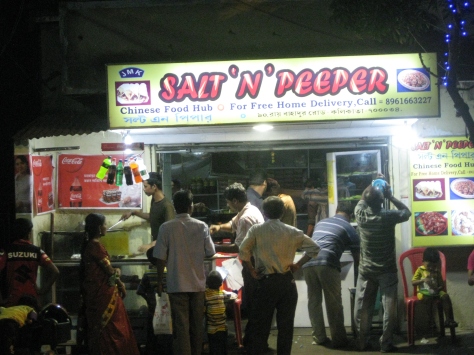
Lacking somewhat in the poetic imagination department, I needed an absence of fourteen years and fifteen Pujo’s to see these familiar sights through the unfamiliar lens of my camera (and of course the opportunity for chronicling the daily that social media has provided in the meantime).

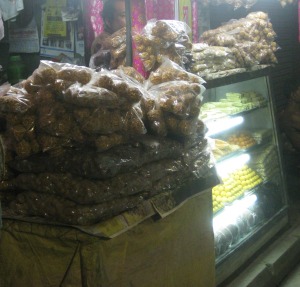
Sadly, mine is a point-and-shoot camera and doesn’t work so well at night. But that isn’t the only reason some of the pictures are blurry.
I found out today that I must be rather shy by nature. I had a hard time walking up to a phuchkawallah or an ice-cream vendor, especially when they were surrounded by at least ten other hungry people and saying, “Excuse me, may I take a picture of your cart?” Sometimes, when I spotted one with no customers and made a movement as if to speak, they increased their crescendo of “gola gola gola” or “kappeee kappee kappee” and I quickly walked on looking rather straight ahead.
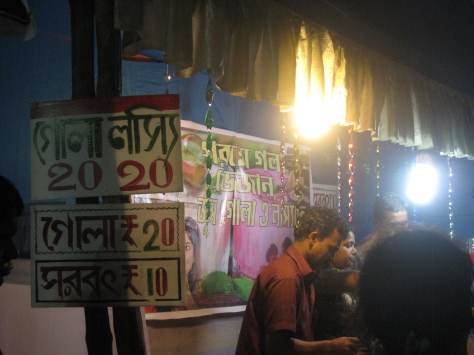
Most people were busy taking pictures of the Pandals and idols and some folks must have found it strange that I stopped with a camera in front of the food carts, especially when the flash went off. So I stood on the other side of the road, wherever it was dark, and quickly took a shot dodging the crowds, the autorickshaws, the bikes, the cycle rickshaws (which seem to have an additional tarpaulin roof extension stretching from the passenger to the driver these days for sun and rain), the dogs, the customers and so many others who inevitably zoomed into my viewfinder.


That my shots are bad is just another way of saying I’m a bad photographer. But I assure you that I do know my Calcutta street food.
No, correction.
I used to. That was fifteen Pujo’s ago. Now I still veer between Calcutta and Kolkata too many times to be one of the real city folks yet. But I’m quickly catching on.
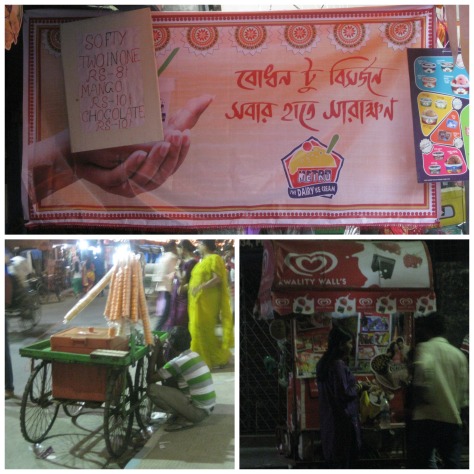

Some of the street food I used to know is still very much here. I am proud to say that the Calcutta street chowmein, dry, fried noodles with a hint of turmeric, cumin and some unidentified black masala, which came to its maturity during my growing years in the city, is still here in its various designations: Chowmin, Chow Chow, just Chow.
So is the “roll” known elsewhere as the “kati roll” (paratha/fried flatbread with a layer of egg inside and an optional choice of kabab-like meat, onions, green chillies and lemon). I think the convenience of holding it as one eats makes it still the most common filling street food in the city (Calcutta, my other city, although it’s popularity is also increasing at a tremendous pace in New York, one of my other cities).
The new fare I’m seeing in Calcutta is the momo as street food, a distant cousin of its Tibetan dumpling brethren in the street stalls. Momo was always there in the vicinity of Elgin Road (and Darjeeling, of course) but I never saw it as street food before. When I tasted it last year in a different context, I found it had a hint of curry powder unlike the momos I knew at Elgin Road.
Mutton and chicken biryani (meat cooked with rice) is also literally everywhere, not just in the restaurants like before, but in red cloth-covered haandi’s at every food stall along the streets. It is the Calcutta style biryani which is lightly spiced, dry, with an egg, a large spiced potato and one or two huge portions of chicken served in a paper box or plate. The box, I notice, is often labelled “Chowmin” in large printed letters but who cares about labels if the food is good?

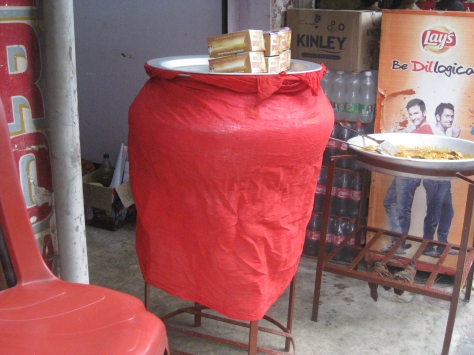
Calcutta’s very own phuchka (known elsewhere in India as golguppa or panipuri, a crispy, thin, fried, puffed dough with spicy tamarind water) is now coming with other water options too such as dahi and meetha paani (yoghurt or sweet water instead of tamarind) known respectively as dahi phuchka and meetha phuchka as in other parts of India. The names have the Hindi touch in most places, perhaps as a nod to that North Indian connection as opposed to their Bengali designations doi (yoghurt) or mishti (sweet) but that is entirely my speculation.
In a matter of days phuchkawallas have literally lined the streets. Many seem to be Hindi-speaking from the neighbouring states and many seem new–their lack of experience revealing the fact that they only do this during the Pujo season. They are far better dressed in shirts and trousers now than I remember and their fare is now variously designated as Phuchka, Fuchka, Puchka where possible on their glass boxes.


Street food was a way of life in my growing years whether it was bought from the alookabliwallah with his spiced, boiled potatoes served with tamarind water on saal leaf bowls outside the school gate or from roadside vendors serving the sliced green, sour fruit aamra sprinkled with beetnoon (rock salt) or the tiny, sour, red berries with huge stones (boichi) that came in white paper cones or black currant noon (a kind of black, electrifyingly sour black powder) that I would eat with a new Enid Blyton book on the back of the school bus. Until the black powder had to stop due to a drug scare outside school premises in the late 80’s.
(This part is terribly hard for me to write in English since I’ve never thought of these food items in my other language. It is so much easier to write about restaurant food in English, much easier to write “steak” or “tikka masala” or “saag chicken” in English than in my other language Bengali, although it’s turning out to be the reverse for street food!)
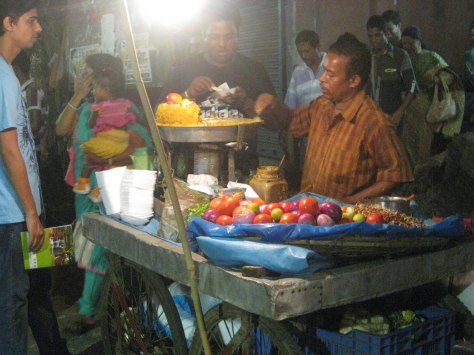
I realized in my meanderings through life that growing up eating street food makes you tough and not just in the gastronomical sense. Eating street food makes you connect to a place and its people and feel a sense of belonging like nothing else will make you do because all restaurants look the same from inside becoming more and more similar around the world the higher up the scale they go no matter whether they aim for the chain effect or a themed ambiance in an attempt to recreate real spaces, especially the newer ones.
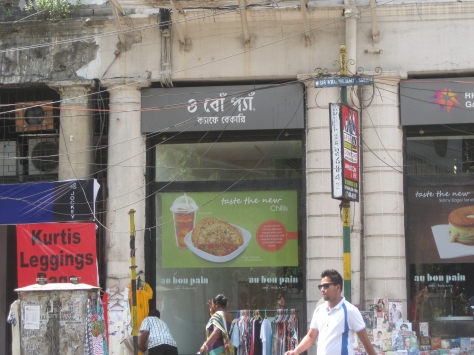
Street food, unlike restaurant food, for me, is real, something that elicits a visceral reaction in me when I spot a food cart from a distance. Street food does not care about uniqueness, authenticity, cultural miscegenation, grammar, spelling or language. It just is and will grow where it can grow against all odds.
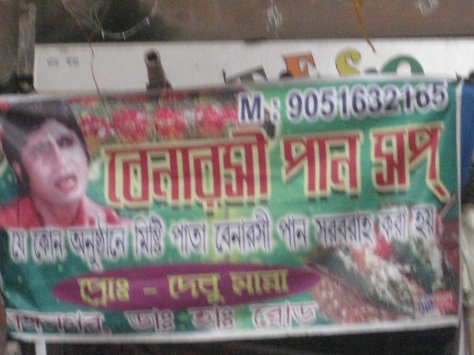
I have felt the same about street food in other places too, not just here in Calcutta. Street food carts would make me rush to the tiny downtown in Gainesville, Florida during the Medieval or Renaissance fair or to the even tinier downtown in Davis, California during the weekly Farmer’s Market. It made me drive to neighbouring Woodland for a solitary Taco Truck to be found parked next to the highway into town.
In New York City and neighbouring Jersey City across the Hudson, the carts selling hot dogs and honey-roasted nuts (Nuts for Nuts, they say) and burgers and waffles and chicken-over-rice and falafel and smoothies and dosas and biryani everyday in rain, sun and snow and cotton candy, roasted corn, skewers of meat, fried doughs, burritos and traditional food from many parts of the world on special festival weeks in the spring and summer made me feel connected to that city space because I’d connected to Calcutta via street food as a child.
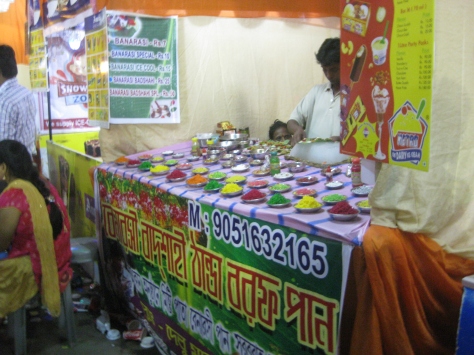
Hence, this Pujo season, while the middle-class Bengalis are going for Pujo Special menus of traditional Bengali fare at expensive restaurants housed in the sparkling malls (another new phenomenon for me) in addition to having all this street food, the cook, the washer-woman, the driver, the car-repair assistants have all been saving for days so they can go Pandal-hopping all night with all the relatives who are visiting from inside and outside the city. They will eat the street food at the vendors and kiosks all evening and night these five days either standing or sitting on plastic chairs which have been laid out especially for the purpose along the streets and barricades.
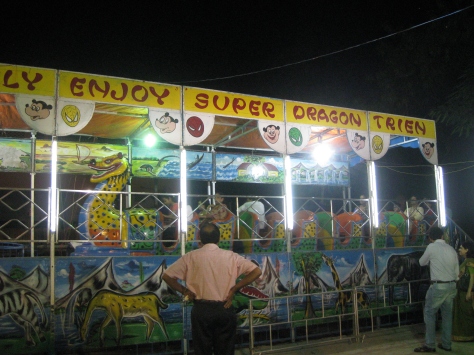

Afterthoughts:
Most of that was was last night. I had to walk the same path once again this afternoon. One of the Pujo’s I wrote about the day before yesterday has got a prestigious award since then at a Pujo competition in addition to many other prizes. All the trophies and certificates are displayed at a kiosk opposite the beautiful gate of the Pandal. That structure is an example of an unparalleled exhibition of artistic craft and extreme erudition regarding the mythology, symbolism and semantics surrounding the Goddess.
On my way here down the now empty sidewalks in daylight, I had noticed that preparations at all the food stalls were already on their way on the roadside for the evening—the gigantic vessels were being washed, lentils had been soaked in aluminium dekchi’s, and chicken was being marinated for the biryani in aluminium boats with metal rings on the sides.
As I moved out of the display area, a very tiny Pujo mandap (structure) attracted my sight in a by-lane that I would ordinarily have overlooked.
As I entered the lane, I saw a row of young boys, all probably between eight to thirteen years of age, sitting on wooden bench-beds (taktaposh’s) on either side of the narrow lane sifting, kneading and rolling out dough. I realized that the dough will probably be fried into the parathas (flatbreads) in the evenings for the thousands of “rolls” which will be consumed by the festive Pujo crowds this Shaptami evening.
A row of relatively nice houses lined the street with metal bars barring the windows and curtains drawn for privacy while Rabindrasangeet (Tagore’s songs) floated here from a nearby festive microphone with its slow, erudite, romantic charm while the boys worked outside.
Mone ki dwidha rekhe gele chole/ Sheidin bhora shaajhe/ Jete jete dooaar hote/ Ki bhebe phirale mukhokhani/ Ki kotha chilo je mone mone . . .
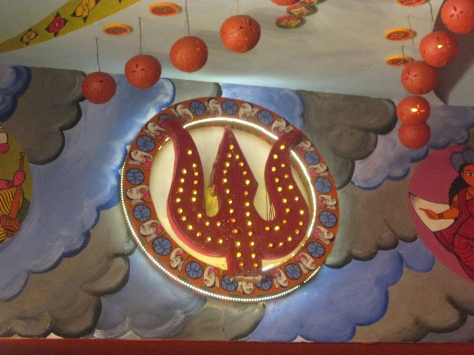
And so I walked on to face my long journey in the drizzling afternoon rain.
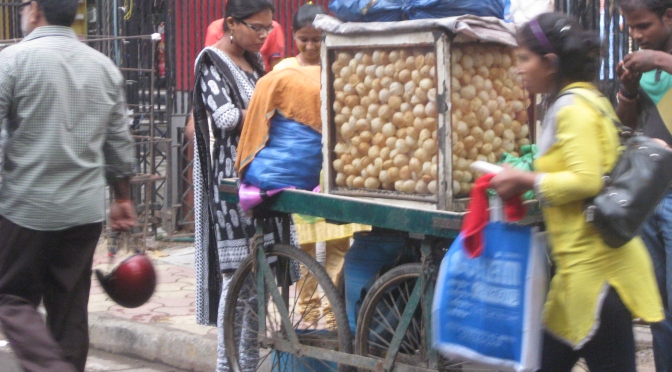
i like , verry good
LikeLike
i like it
LikeLike
wow, diverse food
LikeLike
I really liked this article. you are a great writer, my favorite. Thank you for sharing..
LikeLike
it turns out there is a view like this almost everywhere as well as in my country
LikeLike
in our country there is an island of indonesia are very pretty namely bali, where there are often events there because the majority hindu religious hindus, have you ever been to bali ?
LikeLike
wow amazing, so crowded, so much variety of food. I so want to go there, I really liked this article. you are a great writer, my favorite. Thank you for sharing
LikeLike
the condition look like in my country too, indonesia. specially about the food. beside pakistan….i also recommended my country to your next visit.
LikeLiked by 2 people
Excellent. I had a real walk through . I must be a part of this wonderful journey next time.
LikeLike
Yes, of course.
LikeLike
Many things to like in your post. Food of course for the French is essential to the way of life and any important event involves also lots of food. So I enjoyed your mouth watering food descriptions a lot. Indian cuisine happens to be one of my very favorite. So I am in heaven as I read your tasty words. Street food, I fully agree, is the pulse of a culture, no other food is as visceral and none makes us feel whole and part of our people. I also feel for the disconnect you evocate, this delicate balance between being an insider and an outsider. The mention of Davis, a place I am very familiar with resonates also with me. But the Pujo season is so foreign to me that I can only imagine through your words how intense it must be for you.
Thank you for sharing all that with us, not an easy task when emotions are so present.
LikeLike
Thanks so much. “Tasty words”–such a nice comment. I’m glad you know Davis! Best town I ever lived in! I’ve been curious about French food but I’ve only had what I think are Americanized versions.
LikeLike
This is a marvelous, marvelous post. First, you gave me the feeling that I was there with you, exploring the sights, sounds, and food of the festival. Second, you put into words how difficult it is to be at a place while also trying to record being at a place. The camera separates us from the events even while we are trying to integrate it and keep it in our memories. Logistically speaking, photographing in a crowd can be a nightmare, at least for this amateur, and then there are the folks who won’t let you take a picture! And third, Slo, your pictures are powerful and imbued with reality. I kept saying ,”This is my favorite,” then scrolling down and saying,”No. this is my favorite”, all through the post. I love it!
LikeLike
Thanks. Taking so many pictures did require effort and it feels nice to be appreciated.
LikeLiked by 1 person
I could draw a dozen commons between Pakistan and India. Street food is up there in the list. Oh how I miss my country now:(. Thanks for the nostalgia and precious memories!
LikeLike
Thanks for reading. I’m curious now about street food in Pakistan.
LikeLike
Definitely worth a post when I visit next time:)
LikeLike